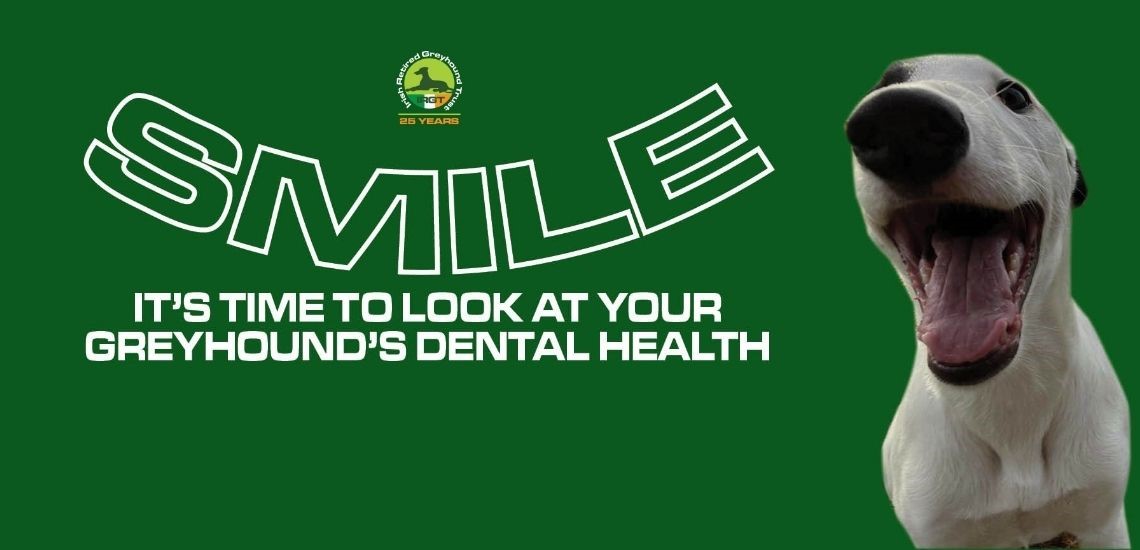Looking After Your Greyhound's Dental Health

Just as for us humans, a greyhound’s dental health is vitally important.
- Dental disease in greyhounds is very common, particularly amongst older dogs.
- Dental disease is caused by the numerous bacteria that live in the mouth and their interaction with the greyhound's immune system.
- As with humans, dental disease can be extremely painful.
- Infection in the mouth can be spread around the body through the bloodstream leading to major health problems if dental issues are left untreated.
The best way to prevent dental disease and keep your greyhound’s mouth healthy is by brushing their teeth every day - and don't forget to brush the teeth at the back of their mouth too! Whilst a human toothbrush is ideal for greyhounds, don't use human toothpaste to clean your dog's teeth as it can be toxic, there are lots of options for doggie toothpastes at your local pet store.
As your greyhound settles in at home with you and you develop a bond and trust between you, you can begin getting them used to you brushing their teeth.
Signs of poor dental health in dogs
- If your greyhound has poor dental health you might find that they are not keen on engaging or participating in activities - they may have gradually become more grumpy over time.
- Your greyhound may exhibit bad breath.
- Your greyhound's teeth may have brown stains or the build up of plaque, especially at the gum line.
- The gums may appear pink and puffy, with brighter pink areas or redness at the base of the tooth. Such gum disease can be present even if the teeth themselves look nice, clean and white.
- You may notice the gum line receding, and the teeth seeming to grow longer - it's actually the root of the tooth becoming visible.
- When brushing your greyhound's teeth you might notice blood on the toothbrush or in your greyhound's mouth - or when they play with their toys you may notice spots of red or pink where they have been holding the toy in their mouth.
Poor dental health does not always result in a greyhound being unwilling to eat or drink so if you see any of the signs above it's time to visit your vet with your greyhound to seek advice.
Bones and teeth
There are many views around giving dogs bones to help clean their teeth and whilst bones can be a tasty treat for dogs and do help keep teeth clean there are potentially significant hazards to consider. Raw, meaty bones can be messy, and cooked bones can fragment and cause internal damage. Other potential issues include dental fractures, constipation, and internal blockages. Dogs should always be supervised if given a bone to chew, and in multi dog households dogs should be separated from each other when bones are given to avoid potential conflicts between individual dogs.
If you're keen to give your greyhound a bone, do speak with your vet first. Ultimately, the most reliable way to keep teeth clean is to brush them daily or as often as you can each week.
How to brush your Greyhound’s Teeth
As with all handling and training activities, take things slowly and gently with your greyhound and make it a positive experience. If at any stage your greyhound pulls away, is consistently looking away and/or licking their lips, panting, or yawning, these are signs of stress and it is time to stop and take a break. When you start your next session, try to begin at a stage at which they were comfortable in the last one.
If you find you're really struggling, do speak to your vet or a qualified behaviourist for advice.
Do undertake the activity in each stage below several times across a number of days until your greyhound is comfortable before moving on to the next stage:
Step 1 - touching their face and around their mouth
- Gently touch your greyhound under their jaw and hold a tasty little treat for them to take from your other hand. Don't forget to gve them lots of praise.
- Once your greyhound is comfortable with this, move on to gently touching the side of their face, stroke along the side of their mouth and cheek, all while offering a little titbit or two.
Step 2 - lifting their lips
- Once they are comfortable and used to you touching their face and around their mouth, gently try lifting their lip each side of their face, slipping your finger beneath the lip to run it along the outside of their teeth. NOTE: If you're nervous of your finger accidentally getting nipped just go as far with this stage as lifting their lips. Don't forget to give lots of praise and treats here too!
Stage 3 - introducing the toothbrush
- Most dog toothpastes come in flavours designed to entice your dog, so they should taste nice to them. Put some toothpaste on your dog's toothbrush and let them have a sniff. Hopefully they will start licking at it and be happy to put the toothbrush in their mouth. If they don't, try the same thing with something tasty for them on there, such as a little bit of cream cheese.
Stage 4 - brushing the teeth
- Once your greyhound is comfortable with having a toothbrush in their mouth, gently lift their lip and begin brushing the teeth in a circular motion. Begin initially brushing just a few teeth before ending the session, and build up over a number of sessions until you can brush all of your dog's teeth, taking short breaks as you go within the session.
Once you've ended a session, give your greyhound lots of praise and a little tasty treat for doing so well!
To download this guide as a printable pdf document, please click here.